Sony FCB-EX980S, FCB-EX1020, FCB-EX980SP, FCB-EX980, FCB-EX980P User Manual
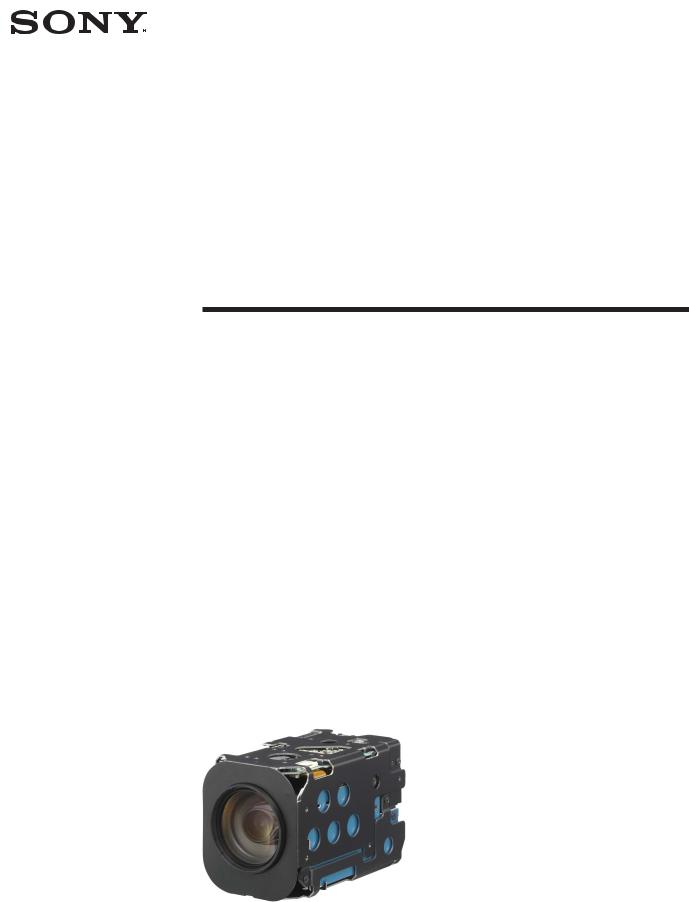
A-DJ7-100-11(2)
Color Camera Module
Technical Manual
FCB-EX1020/EX1020P
2010 Sony Corporation
Table of Contents
Features ..................................................................... |
3 |
Precautions ................................................................ |
4 |
Locations of Controls ............................................... |
5 |
Basic Functions ......................................................... |
6 |
Overview of Functions ................................................ |
6 |
Eclipse ...................................................................... |
21 |
Spectral Sensitivity Characteristics .......................... |
21 |
Vibration Specifications ............................................ |
21 |
Key Switch Circuitry ................................................. |
22 |
Key Function Specifications ..................................... |
23 |
Initial Settings, Custom Preset and Backup ............. |
26 |
Mode Condition ........................................................ |
28 |
Command List ......................................................... |
31 |
VISCA/RS-232C Commands ................................... |
31 |
FCB Camera Commands ......................................... |
37 |
Specifications .......................................................... |
58 |
2

Overview
Features
•The EX-view HADTM CCD features 380,000 (NTSC) or 440,000 (PAL) effective picture elements and high-sensitivity shooting. The minimum illumination required is 1.4 lux (1/60 s (NTSC), 1/50 s (PAL), ICR OFF).
•A CCD for shooting a wide dynamic range is employed to perform progressive or interlaced scanning, and images with a wide dynamic range are obtained by a newly developed image signal processor (Wide Dynamic Range function). Furthermore, it is possible to automatically switch to this Wide Dynamic Range function, which enables you to obtain optimal images ranging from the dark areas of a subject to the light areas.
•Low-noise images can be obtained even in low light environments using the 3D Noise Reduction (3D NR + 2D NR) function.
•A function to output interlaced or progressive images by digital output (equivalent to ITU-R BT656) is provided.
•36× optical zoom (432× with digital zoom)
•A Image Stabilizer function enables stable shooting.
•Supporting external synchronization (V-lock)
•Images with a high resolution (550 TV lines) can be obtained using a newly developed Image Signal Processor for improved picture quality.
•An infrared (IR) Cut-Filter can be disengaged from the image path for increased sensitivity in low light environments. The ICR will automatically engage depending on the ambient light, allowing the camera to be effective in day/night environment.
•VISCA is a communications protocol, which enables the camera to be controlled remotely from a host computer/controller.
•Six memory locations are provided to temporally save and recall up to six sets of camera settings.
•A Privacy Zone Masking function (max. 24 blocks) is available.
•A mosaic masking function has been added to the privacy zone masking function.
•A title composed of up to 11 lines can be set for displaying on the screen. 20 characters can be used on one line.
•E-FLIP and Mirror Image functions
•Alarm function with adjustable detection zones
•Adjustable AE response speed
With consideration given environmental protection, this module is designed to operate with low power consumption and also incorporates lead-free and halogen-free circuit boards.
3

Software
Use of the demonstration software developed by Sony Corporation or use of the software with customer developed application software may damage hardware, the application program or the camera. Sony Corporation is not liable for any damages under these conditions.
Operation
Start the camera control software on your computer after you turn on the camera and the image is displayed.
Operation and storage locations
Do not shoot images that are extremely bright (e.g., light sources, the sun, etc.) for long periods of time. Do not use or store the camera in the following extreme conditions:
•Extremely hot or cold places (operating temperature –5 ˚C to +60 ˚C (41 ˚F to 140 ˚F))
•Close to generators of powerful electromagnetic radiation such as radio or TV transmitters
•Where it is subject to fluorescent light reflections
•Where it is subject to unstable (flickering, etc.) lighting conditions
•Where it is subject to strong vibration
•Where it is subject to radiation from laser beams
Care of the unit
Remove dust or dirt on the surface of the lens with a blower (commercially available).
Other
Do not apply excessive voltage. (Use only the specified voltage.) Otherwise, you may get an electric shock or a fire may occur.
Overview
Precautions
In case of abnormal operation, contact your authorized Sony dealer or the store where you purchased the product.
Phenomena specific to CCD image sensors
The following phenomena that may appear in images are specific to CCD (Charge Coupled Device) image sensors. They do not indicate malfunctions.
White flecks
Although the CCD image sensors are produced with high-precision technologies, fine white flecks may be generated on the screen in rare cases, caused by cosmic rays, etc.
This is related to the principle of CCD image sensors and is not a malfunction.
The white flecks especially tend to be seen in the following cases:
•when operating at a high environmental temperature
•when you have raised the master gain (sensitivity)
•when operating in Slow-Shutter mode
Vertical smear
When an extremely bright object, such as a strong spotlight or flashlight, is being shot, vertical tails may be produced on the screen, or the image may be distorted.
|
Vertical tails shown on the |
Monitor screen |
image. |
Bright object
(e.g. strong spotlight, strong reflected light, flashlight, the sun)
Aliasing
When fine patterns, stripes, or lines are shot, they may appear jagged or flicker.
4
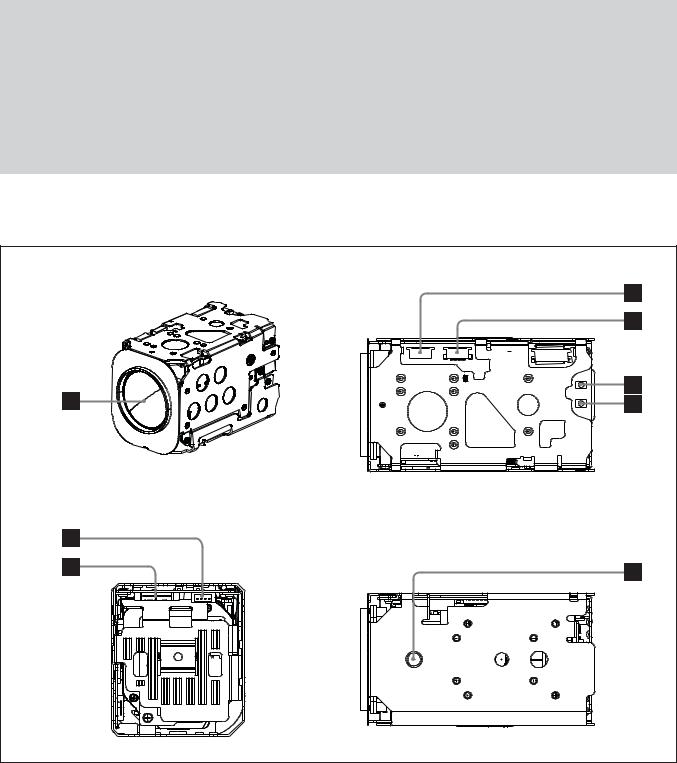
Locations of Controls
Locations of Controls
Front |
Top |
Back
Bottom
1 Lens |
5 CN200 jack (for digital output) |
2 CN500 jack |
6 TELE button |
3 CN501 jack |
7 WIDE button |
4 CN702 jack (for key SW) |
|
8Tripod screw hole
When a tripod is used, please use 7 mm (9/32 in.) or less screw to attach it to the camera. Also, please be sure to attach the tripod securely.
5
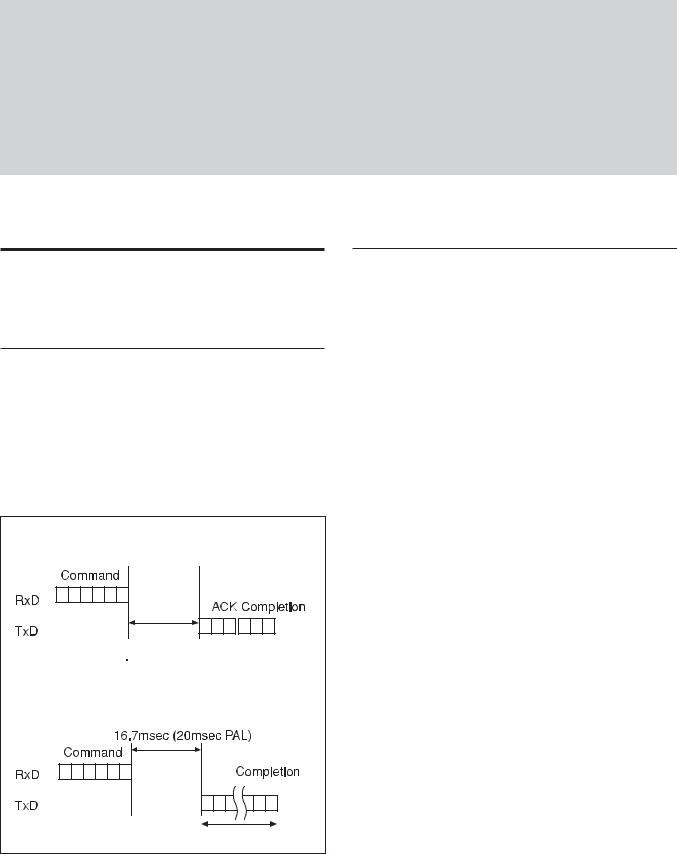
Basic Functions
Basic Functions
Overview of Functions
VISCA commands are the basis of camera control.
Timing Chart
As VISCA Command processing can only be carried out one time in a Vertical cycle, it takes the maximum 1V cycle time for an ACK/Completion to be returned. If the Command ACK/Completion communication time can be cut shorter than the 1V cycle time, then every 1V cycle can receive a Command.
General Commands
Within 









Query Commands
Within
16 Byte
In general
•Power On/Off
Powers the camera on and off. When the power is off, the camera is able to accept only the lowest level of VISCA Commands; the display and other features are turned off.
•I/F Clear
Clears the Command buffer of the FCB camera. Clearing the buffer can also be carried out from the control application software when the power is on.
•Address Set
VISCA is a protocol, which normally supports a daisy chain of up to seven connected cameras via RS232C interface. In such cases, the address set command can be used to assign addresses from 1 to 7 to each of the seven cameras, allowing you to control the seven cameras with the same personal computer. Although the FCB camera does not support direct connection of cameras in a daisy chain, be sure to use the address set command to set the address whenever a camera is connected for the first time.
•ID Write
Sets the camera ID.
•Mute
Blanks the screen and sends out a synchronizing signal.
•Lens Initialize
Initializes the zoom and focus of the lens. Even when power is already on, it initializes the zoom and the focus.
•Comp Scan
A pixel blemish-masking feature, which can be made to reevaluate overall CCD pixel blemishes and mask severely flawed pixels automatically upon receiving the COMP SCAN command. This feature helps to mask the flaws found in CCD imagers, even after the camera has been powered on for some time.
6

Zoom
The FCB camera employs a 36× optical zoom lens combined with a digital zoom function; this camera allows you to zoom up to 432×.
• Optical 36×, f = 3.4 to 122.4 mm (F 1.6 to F 4.5)
The horizontal angle of view is approximately 57.8 degrees (wide end) to 1.7 degrees (tele end). Digital Zoom enlarges the center of the subject by expanding each image in both the vertical and horizontal directions. When 432× zoom is used, the
number of effective picture elements in each direction reduces to 1/12 and the overall resolution deteriorates.
You can activate the zoom in the following three ways
•By pressing the TELE or WIDE buttons on the camera itself
•Using a VISCA Command
Using Standard Mode
Using Variable Mode
There are eight levels of zoom speed.
Direct Mode
Setting the zoom position enables quick movement to the designated position.
Digital Zoom ON/OFF
In these standard and variable Speed Modes, it is necessary to send Stop Command to stop the zoom operation.
•The Zoom Mode supports a Combined Mode and a Separate Mode.
Combined Mode
This is the previously existing zoom method. After the optical zoom has reached its maximum level, the camera switches to Digital Zoom Mode.
Separate Mode
In this mode, Optical Zoom and Digital Zoom can be operated separately. You can use digital zoom magnification at any time from within any level of optical magnification.
About Continues Zoom position Reply
With ZoomDirect mode, or when zooming according to a preset, the camera outputs zoom position data when Continues Zoom position Reply is set to ON via a command.
Continues Zoom position Reply: y0 07 04 69 0p 0p 0q 0q 0q 0q FF
pp: D-Zoom position
qqqq:Zoom position
•Using an external key switch board connected to the jack for the key SW.
Basic Functions
Focus
Focus has the following modes, all of which can be set using VISCA Commands.
•Auto Focus Mode
The minimum focus distance is 320 mm at the optical wide end and 1500 mm at the optical tele end, and is independent of the digital zoom.
The Auto Focus (AF) function automatically adjusts the focus position to maximise the high frequency content of the picture in a center measurement area, taking into consideration the high luminance and strong contrast components.
- Normal AF Mode
This is the normal mode for AF operations.
- Interval AF Mode
The mode used for AF movements carried out at particular intervals. The time intervals for AF movements and for the timing of the stops can be set in one-second increments using the Set Time Command. The initial value for both is set to five seconds.
- Zoom Trigger Mode
When the zoom is changed with the TELE or the WIDE buttons, the pre-set value (initially set at 5 seconds) becomes that for AF Mode. Then, it stops.
AF sensitivity can be set to either Normal or LOW.
- Normal
Reaches the highest focus speed quickly. Use this when shooting a subject that moves frequently. Usually, this is the most appropriate mode.
- LOW
Improves the stability of the focus. When the lighting level is low, the AF function does not take effect, even though the brightness varies, contributing to a stable image.
•Manual Focus Mode
Manual Focus has both a Standard Speed Mode and a Variable Speed Mode. Standard Speed Mode focuses at a fixed rate of speed. Variable Speed Mode has eight speed levels that can be set using a VISCA Command.
In these standard and variable Speed Modes, it is necessary to send Stop Command to stop the zoom operation.
•One Push Trigger Mode
When a Trigger Command is sent, the lens moves to adjust the focus for the subject. The focus lens then holds that position until the next Trigger Command is input.
•Infinity Mode
The lens is forcibly moved to a position suitable for an unlimited distance.
•Near Limit Mode
Can be set in a range from 1000 (∞) to C000 (10 mm).
7

White Balance
White Balance has the following modes, all of which can be set using VISCA Commands.
•Auto White Balance
This mode computes the white balance value output using color information from the entire screen. It outputs the proper value using the color temperature radiating from a black subject based on a range of values from 3000 to 7500K.
This mode is the factory setting.
•ATW
Auto Tracing White balance (2000 to 10000K)
•Indoor
3200K Base Mode
•Outdoor
5800K Base Mode
•One Push WB
The One Push White Balance mode is a fixed white balance mode that may be automatically readjusted only at the request of the user (One Push Trigger), assuming that a white subject, in correct lighting conditions, and occupying more than 1/2 of the image, is submitted to the camera.
One Push White Balance data is lost when the power is turned off. If the power is turned off, reset One Push White Balance.
•Manual WB
Manual control of R and B gain, 256 steps each
•Outdoor Auto
This is an auto white balance mode specifically for outdoors. It allows you to capture images with natural white balance in the morning and evening.
•Sodium Vapor Lamp Auto
This is an auto white balance mode that is compatible with sodium vapor lamps.
•Sodium Vapor Lamp
This is a fixed white balance mode specifically for sodium vapor lamps.
Automatic Exposure Mode
A variety of AE functions are available for optimal output of subjects in lighting conditions that range from low to high.
•Full Auto
Auto Iris and Gain, Fixed Shutter Speed (NTSC: 1/60 sec., PAL: 1/50 sec.)
•Gain Limit Setting
The gain limit can be set in the AE mode. Use this setting when image signal-to-noise ratio is particularly important.
Basic Functions
•Shutter Priority 1)
Variable Shutter Speed, Auto Iris and Gain
(1/1 to 1/10,000 sec., 16 high-speed shutter speeds
plus 6 low-speed shutter speeds)
1)Flicker can be eliminated by setting shutter to
t1/100s for NTSC models used in countries with a 50 Hz power supply frequency
t1/120s for PAL models used in countries with a 60 Hz power supply frequency
•Iris Priority
Variable Iris (F1.6 to Close, 18 steps), Auto Gain and Shutter speed
•Manual
Variable Shutter, Iris and Gain
•Bright
Variable Iris and Gain (Close to F1.6, 17 steps at 0 dB: F1.6, 15 steps from 0 to 28 dB)
AE – Shutter priority
The shutter speed can be set freely by the user to a total of 22 steps – 16 high speeds and 6 low speeds. When the slow shutter is set, the speed can be 1/30s, 1/15s, 1/8s, 1/4s, 1/2s, 1/1s. The picture output is read at a normal rate from the memory. The memory is updated at a low rate from the CCD. AF capability is low.
In high speed mode, the shutter speed can be set up to 1/10,000s. The iris and gain are set automatically, according to the brightness of the subject.
Data |
NTSC (s) |
PAL (s) |
|
|
|
15 |
1/10000 |
1/10000 |
|
|
|
14 |
1/6000 |
1/6000 |
|
|
|
13 |
1/4000 |
1/3500 |
|
|
|
12 |
1/3000 |
1/2500 |
|
|
|
11 |
1/2000 |
1/1750 |
|
|
|
10 |
1/1500 |
1/1250 |
|
|
|
0F |
1/1000 |
1/1000 |
|
|
|
0E |
1/725 |
1/600 |
|
|
|
0D |
1/500 |
1/425 |
|
|
|
0C |
1/350 |
1/300 |
|
|
|
0B |
1/250 |
1/215 |
|
|
|
0A |
1/180 |
1/150 |
|
|
|
09 |
1/125 |
1/120 |
|
|
|
08 |
1/100 |
1/100 |
|
|
|
07 |
1/90 |
1/75 |
|
|
|
06 |
1/60 |
1/50 |
|
|
|
05 |
1/30 |
1/25 |
|
|
|
04 |
1/15 |
1/12 |
|
|
|
03 |
1/8 |
1/6 |
|
|
|
02 |
1/4 |
1/3 |
|
|
|
01 |
1/2 |
1/2 |
|
|
|
00 |
1/1 |
1/1 |
|
|
|
8
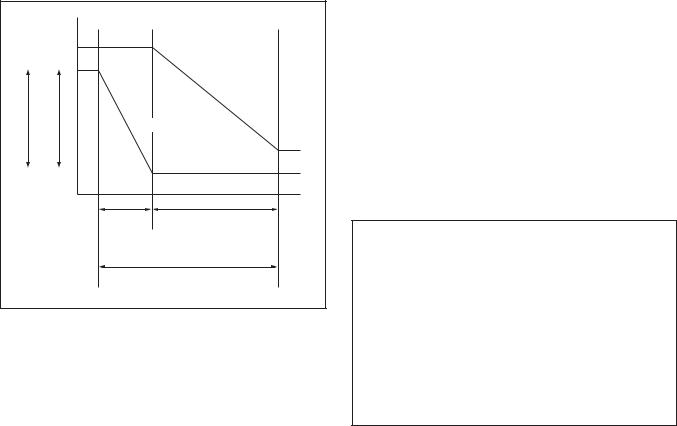
AE – Iris priority
The iris can be set freely by the user to 18 steps between F1.6 and Close.
The gain and shutter speed are set automatically, according to the brightness of the subject.
Data |
Setting value |
Data |
Setting value |
|
|
|
|
11 |
F1.6 |
08 |
F8 |
|
|
|
|
10 |
F2 |
07 |
F9.6 |
|
|
|
|
0F |
F2.4 |
06 |
F11 |
|
|
|
|
0E |
F2.8 |
05 |
F14 |
|
|
|
|
0D |
F3.4 |
04 |
F16 |
|
|
|
|
0C |
F4 |
03 |
F19 |
|
|
|
|
0B |
F4.8 |
02 |
F22 |
|
|
|
|
0A |
F5.6 |
01 |
F28 |
|
|
|
|
09 |
F6.8 |
00 |
CLOSE |
|
|
|
|
AE – Manual
The shutter speed (22 steps), iris (18 steps) and gain (16 steps) can be set freely by the user.
AE – Bright
The bright control function adjusts both gain and iris using an internal algorithm, according to a brightness level freely set by the user. Exposure is controlled by gain when dark, and by iris when bright.
As both gain and iris are fixed, this mode is used when exposing at a fixed camera sensitivity. When switching from Full Auto or Shutter Priority Mode to Bright Mode, the current status will be retained for a short period of time.
Only when the AE mode is set to “Full Auto” or “Shutter Priority,” can you switch it to “Bright.”
Gain |
|
IRIS AGC |
|
OPEN MAX |
|
|
IRIS curve |
|
Gain curve |
CLOSE MIN |
|
Dark |
Bright |
Controlled |
Controlled by IRIS |
by gain |
|
Bright limit which controllable for this unit
Basic Functions
Data |
Iris |
Gain |
Data |
Iris |
Gain |
|
|
|
|
|
|
1F |
F1.6 |
28 dB |
0F |
F2.4 |
0 dB |
|
|
|
|
|
|
1E |
F1.6 |
26 dB |
0E |
F2.8 |
0 dB |
|
|
|
|
|
|
1D |
F1.6 |
24 dB |
0D |
F3.4 |
0 dB |
|
|
|
|
|
|
1C |
F1.6 |
22 dB |
0C |
F4 |
0 dB |
|
|
|
|
|
|
1B |
F1.6 |
20 dB |
0B |
F4.8 |
0 dB |
|
|
|
|
|
|
1A |
F1.6 |
18 dB |
0A |
F5.6 |
0 dB |
|
|
|
|
|
|
19 |
F1.6 |
16 dB |
09 |
F6.8 |
0 dB |
|
|
|
|
|
|
18 |
F1.6 |
14 dB |
08 |
F8 |
0 dB |
|
|
|
|
|
|
17 |
F1.6 |
12 dB |
07 |
F9.6 |
0 dB |
|
|
|
|
|
|
16 |
F1.6 |
10 dB |
06 |
F11 |
0 dB |
|
|
|
|
|
|
15 |
F1.6 |
8 dB |
05 |
F14 |
0 dB |
|
|
|
|
|
|
14 |
F1.6 |
6 dB |
04 |
F16 |
0 dB |
|
|
|
|
|
|
13 |
F1.6 |
4 dB |
03 |
F19 |
0 dB |
|
|
|
|
|
|
12 |
F1.6 |
2 dB |
02 |
F22 |
0 dB |
|
|
|
|
|
|
11 |
F1.6 |
0 dB |
01 |
F28 |
0 dB |
|
|
|
|
|
|
10 |
F2 |
0 dB |
00 |
CLOSE |
0 dB |
|
|
|
|
|
|
When switching from the Shutter Priority mode to the Bright mode, the shutter speed set in the Shutter Priority mode is maintained.
Spot Exposure Mode
In Full Auto AE, the level for the entire screen is computed and the optimum Auto Iris and Gain levels are determined. In Spot AE, a particular section of the subject can be designated, and then that portion of the image can be weighted and a value computed so that Iris and Gain can be optimized to obtain an image. For example, in an image with a lot of movement and with varying levels of brightness, portions without much change can be designated as such a “spot,” and changes to the screen can be minimized in that area. As shown in the diagram below, a range of 16 blocks vertically and 16 blocks horizontally can be designated.
In the case where the center is designated (shown in black), the level is computed along with a weighted value for the surrounding block (shaded), including the specified portions; and then the Gain and Iris are set. The value of the designated portions and the surrounding areas should be calculated as 100%, the rest should be set to 20%. The range of the Spot AE frame is fixed to 5 blocks vertically and 4 blocks horizontally.
|
|
|
|
|
|
Horizontal 16 |
||||||||||
|
0 1 2 3 4 5 6 7 8 9 A B C D E F |
|||||||||||||||
0 |
|
|
|
|
|
|
|
|
|
|
|
|
|
|
|
|
1 |
|
|
|
|
|
|
|
|
|
|
|
|
|
|
|
|
2 |
|
|
|
|
|
|
|
|
|
|
|
|
|
|
|
|
Vertical 16 43 |
|
|
|
|
|
|
|
|
|
|
|
|
|
|
|
|
|
|
|
|
|
|
|
|
|
|
|
|
|
|
|
|
|
5 |
|
|
|
|
|
|
|
|
|
|
|
|
|
|
|
|
6 |
|
|
|
|
|
|
|
|
|
|
|
|
|
|
|
|
7 |
|
|
|
|
|
|
|
|
|
|
|
|
|
|
|
|
8 |
|
|
|
|
|
|
|
|
|
|
|
|
|
|
|
|
9 |
|
|
|
|
|
|
|
|
|
|
|
|
|
|
|
|
A |
|
|
|
|
|
|
|
|
|
|
(8,8) |
|
|
|
|
|
B |
|
|
|
|
|
|
|
|
|
|
|
|
|
|
|
|
C |
|
|
|
|
|
|
|
|
|
|
|
|
|
|
|
|
D |
|
|
|
|
|
|
|
|
|
|
|
|
|
|
|
|
E |
|
|
|
|
|
|
|
|
|
|
|
|
|
|
|
|
F |
|
|
|
|
|
|
|
|
|
|
|
|
|
|
|
|
9
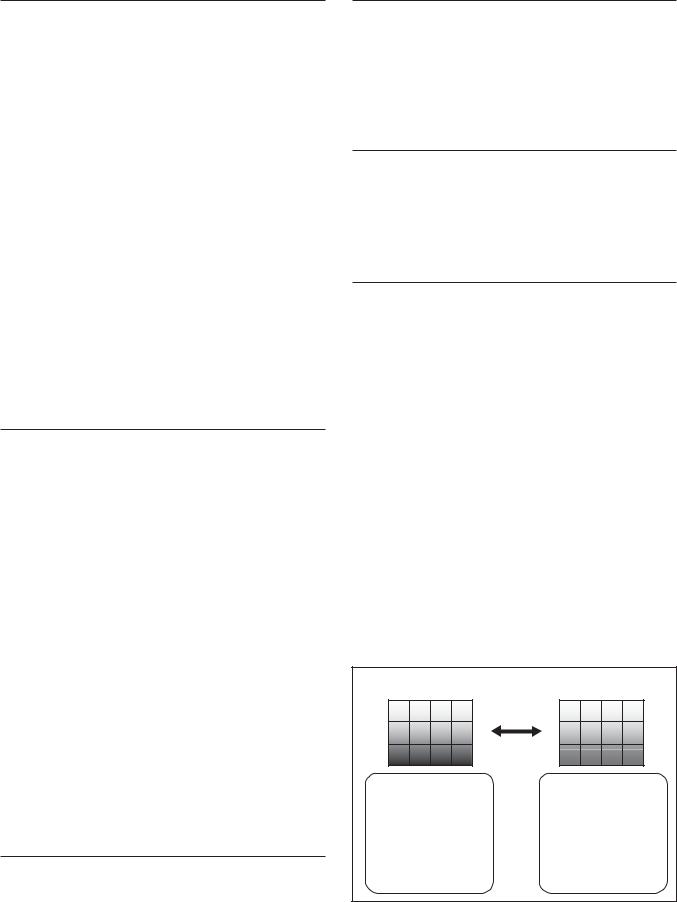
Exposure Compensation
Exposure compensation is a function which offsets the internal reference brightness level used in the AE mode, by steps of 1.5 dB.
Data |
Step |
Setting value |
|
|
|
0E |
7 |
10.5 dB |
|
|
|
0D |
6 |
9 dB |
|
|
|
0C |
5 |
7.5 dB |
|
|
|
0B |
4 |
6 dB |
|
|
|
0A |
3 |
4.5 dB |
|
|
|
09 |
2 |
3 dB |
|
|
|
08 |
1 |
1.5 dB |
|
|
|
07 |
0 |
0 dB |
|
|
|
06 |
–1 |
–1.5 dB |
|
|
|
05 |
–2 |
–3 dB |
|
|
|
04 |
–3 |
–4.5 dB |
|
|
|
03 |
–4 |
–6 dB |
|
|
|
02 |
–5 |
–7.5 dB |
|
|
|
01 |
–6 |
–9 dB |
|
|
|
00 |
–7 |
–10.5 dB |
|
|
|
Slow AE (Automatic Exposure)
The slow AE Response (automatic exposure) function allows you to reduce the exposure response speed. Usually the camera is set up so that the optimum exposure can be obtained automatically within about 1 second. However, using the slow AE response function allows you to lengthen the automatic exposure response speed from the factory setup speed (01 (hex) up to approx. two minutes (30 (hex)).
For example, with the normal setting (about 1 second), if the headlights of a car are caught by the camera, the camera automatically adjusts the exposure so that it can shoot a high-intensity subject (in this case, the headlights). As a result, images around the headlights, that is, the rest of the subject, except the headlights, becomes relatively dark, and poorly distinguished. However, using the slow AE function means the AE response speed will be slower, and response time will be longer. As a result, even if the camera catches a high-intensity subject (e.g., the headlights) for a moment, you can still easily distinguish the portions of the image surrounding the headlights.
High Resolution Mode (Default)
A newly developed ISP function enables the filtering of signals. This allows the camera to provide images with a high resolution (550 TV lines).
Basic Functions
Aperture Control
Aperture control is a function which adjusts the enhancement of the edges of objects in the picture. There are 16 levels of adjustment, starting from “no enhancement.” When shooting text, this control may help by making them sharper.
Back Light Compensation
When the background of the subject is too bright, or when the subject is too dark due to shooting in the AE mode, back light compensation will make the subject appear clearer.
Wide Dynamic Range Mode (WD)
The Wide Dynamic Range mode is a function for dividing an image into several blocks and correcting blocked-up shadows and blown-out highlights in accordance with the intensity difference. It enables you to obtain images in which portions ranging from dark to light can be recognized, even when capturing a subject with a large intensity difference that is backlit or includes extremely light portions.
A CCD for shooting a wide dynamic range is employed, and a newly developed image signal processor combines a long exposure signal (normal shutter) and a signal of the high intensity portions obtained by a short exposure (high-speed shutter) to achieve images with a wide dynamic range.
Wide Dynamic Range Auto On/Off Mode
The wide dynamic range can be set to be automatically switched ON/OFF in accordance with the intensity difference obtained by dividing an image into several blocks and then averaging the intensity of each block.
Wide Dynamic Range Auto On/Off Mode
Auto On/Off
When the intensity |
When the subject |
difference between the |
changes and the |
dark portions and light |
intensity difference |
portions of a subject |
between the dark |
becomes large because |
portions and light |
of back lighting or the |
portions becomes |
like, the wide dynamic |
small, the wide dynamic |
range mode is switched |
range mode is switched |
ON. |
OFF. |
10

The wide dynamic range mode includes the following operation modes.
•WD Mode
This mode corrects blocked-up shadows and blownout highlights in accordance with the intensity difference.
•WD Auto ON/OFF Mode
This mode switches WD ON/OFF automatically in accordance with the intensity difference of the subject. Configure the sensitivity for when WD is switched from OFF to ON with the detection sensitivity parameter.
•Exposure Ratio Mode
This mode fixes the shutter speed of a short exposure. Configure the shutter speed of a long exposure by setting the ratio with regards to a short exposure with the exposure ratio parameter.
Blocked-up shadow correction is not performed in this mode.
•Histogram Mode
This mode uses a histogram to correct blocked-up shadows and blown-out highlights. (The operation is similar to that of FCB-EX1010/P Dver.)
About WD Set Parameter
(Command: 8x 01 04 2D 0p 0q 0r 0s 0t 0u 00 00 FF)
p:Screen display (0: Combined image, 1: Long/short division, 2: Long-time, 3: Short-time)
Set the screen display to a WD combination image, long/short exposure division image, long exposure image, or short exposure image.
q:Detection sensitivity (0: Low, 1: Mid, 2: Hi) Select from three levels for detecting the intensity within the image for when switching Auto WD from OFF to ON.
r:Blocked-up shadow correction level can be set to one of four levels. (0:L 1:M 2:H 3:S)
s:Blown-out highlight correction level can be
set to one of three levels. (0:L 1:M 2:H)
tu: Parameter to use in the exposure ratio mode. Specify the short exposure time by setting the magnification ratio (×1 to ×150) with regards to a long exposure time.
Note
When the wide dynamic range mode is ON, solarization may be observed in the images of some subjects. This phenomenon is unique to wide dynamic range mode, and is not an indication of a camera malfunction.
Noise Reduction
The NR (Noise Reduction) function removes noise (both random and non-random) to provide clearer images. By combining 2D filtering according to brightness and image color, and 3D filtering according to noise caused by motion and time difference, lower-
Basic Functions
noise images can be obtained for the corresponding image brightness of a moving subject.
This function has six steps: levels 1 to 5, plus off. Level 1 applies to subject motion mainly using 2D filter effects. With level 5, 2D and 3D filter effects are maximized, providing the lowest-noise images, although moving subjects may show trails.
At each level, two filters are set according to noise and image motion characteristics, so the available level selections depend on the situation. The default setting is level 3.
StableZoom™
StableZoom is a function for performing correction using the Image Stabilizer function in accordance with the zoom ratio, and smoothly zooming up to approximately ×40 using a combination of the optical zoom and digital zoom. The digital zoom can be further used to zoom up to ×432.
At the wide end, you can obtain images without any reduction in the angle of view and resolution because the digital zoom is not switched ON. On the other hand, at the Tele end, the correction effect by the Image Stabilizer function is at its maximum so blurring is reduced.
The StableZoom function can be switched ON/OFF in the register settings.
x432 |
Blurring is corrected in this |
digital zoom area. |
|
approx. |
StableZoom |
x40 |
Digital zoom |
|
|
x36 |
|
|
Optical zoom |
Zoom |
|
ratio |
|
The digital zoom is not switched ON at the wide end.
Wide |
Optical zoom position |
Tele |
Angle of view and resolution
Color Enhancement
A captured color image is converted to 256 levels of gray, and the binarization process is performed to convert all gray levels brighter than the threshold value to white, and all gray levels darker than the threshold value to black. (Any value can be set for the threshold level and hysteresis width.) Furthermore, any color can be assigned to each of the negative and positive.
11
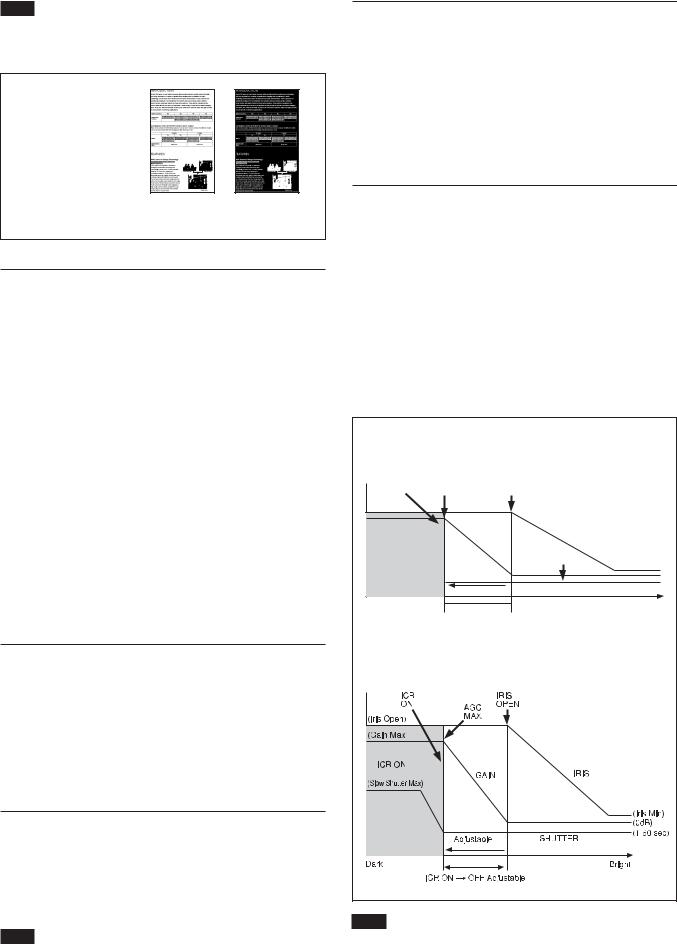
Note
Flickering in images during color enhancement is not an indication of a camera malfunction. It can be reduced with the threshold level, hysteresis width, and edge enhancement (aperture) settings.
Grayscale image (256 levels)
Color image 
Binarization |
Assign any |
process |
color |
Image Stabilizer
Switching ON the Image Stabilizer function reduces image blurring caused by, for example, vibration, which allows you to obtain images without much blurring. A correction effect of approximately 90% is possible for a vibration frequency of around 10 Hz. The Image Stabilizer function employs the digital zoom system, so the angle of view and resolution are changed, but the sensitivity is maintained.
Hold Function of Image Stabilizer
With the Image Stabilizer function, suddenly stopping high-speed movement (pan, tilt, etc.) of the camera produces a blur sensor counteraction that may cause image movement. In such a case, you can use a command setting (hold) to maintain the correction of the Image Stabilizer function. In this case the image stabilizer is off, but there is no change in the angle of view.
Temperature Reading Function
The conversion value (hex) of the temperature sensor built into to the camera can be read by using a query command. The conversion value has an error of ±3 C, and because the temperature sensor is inside the camera, this value is not the ambient temperature. Use it as a reference value.
Slow shutter – Auto/Manual
When set to “Auto,” ensures that the slow shutter is set automatically when the brightness drops. Effective only when the AE mode is set to “Full Auto.”
Set to “Slow Shutter Manual” at shipment.
Note
The Slow Shutter Auto function is not available in WD mode.
Basic Functions
ICR (IR Cut-Removable) Mode
An infrared (IR) Cut-Filter can be disengaged from the image path for increased sensitivity in low light environments. The ICR will automatically engage depending on the ambient light, allowing the camera to be effective in day/night environments.
When the auto ICR mode is set to ON, the image becomes black and white.
Auto ICR Mode
Auto ICR Mode automatically switches the settings needed for attaching or removing the IR Cut Filter. With a set level of darkness, the IR Cut Filter is automatically disabled (ICR ON), and the infrared sensitivity is increased. With a set level of brightness, the IR Cut Filter is automatically enabled (ICR OFF). Also, on systems equipped with an IR light, the internal data of the camera is used to make the proper decisions to avoid malfunctions.
Auto ICR Mode operates with the AE Full Auto setting.
When Auto Slow Shutter is OFF (initial setting)
Shutter 1/60 sec
|
AGC |
IRIS |
ICR |
MAX |
OPEN |
|
GAIN |
IRIS |
ICR ON |
|
SHUTTER |
Dark |
|
Bright |
ICR OFF t ON
When Auto Slow Shutter is ON
Note
When in Auto_ICR_OFF state and WB data is added (default), a malfunction may occur when the subjects largely consisting of blue and green colors are taken.
12

Camera ID
The ID can be set up to 65,536 (0000 to FFFF). As this will be memorized in the nonvolatile memory inside, data will be saved regardless of whether it has been backed up.
Effect
It consists of the following functions.
•Neg. Art: Negative/Positive Reversal
•Black White: Monochrome Image
Others
E-FLIP
This function turns the video output from the camera upside down.
Mirror Image
This function reverses the video output from the camera horizontally.
Freeze
This function captures an image in the field memory of the camera so that this image can be output continuously.
Because communication inside the camera is based on V cycle, the captured image is always the one 3V to 4Vs after the sending of a Command. Thus, you can not specify a time period after sending EVEN, ODD or a Command.
Memory (Position preset)
Using the position preset function, 6 sets of camera shooting conditions can be stored and recalled.
This function allows you to achieve the desired status instantly, even without adjusting the following items each time.
•Zoom Position
•Digital Zoom On/Off
•Focus Auto/Manual
•Focus Position
•AE Mode
•Shutter control parameters
•Bright Control
•Iris control parameters
•Gain control parameters
•Exposure Compensation On/Off
•Exposure Level
•Backlight Compensation On/Off
•Slow Shutter Auto/Manual
•Slow AE Response speed
•White Balance Mode
•R/B Gain
•Aperture
•ICR Shoot On/Off
•WD On/Off
Basic Functions
Custom Preset
As with the position preset function, the camera shooting conditions can be stored and recalled. The settings are recalled when the power is turned on.
For setting items, see the “Initial Settings, Custom Preset and Backup” section on page 26.
User Memory Area
A user area of 16 bytes allows you to write data, such as an ID for each customer, data for each system, and so on, freely.
Note
Rewriting of memory is not unlimited. Be careful to avoid using the memory area for such as unnecessary tasks as rewriting the contents of the memory for every operation.
Register Setting
The camera’s default settings can be changed by the register setting command.
Register Setting Command: 8x 01 04 24 mm 0p 0q FF
mm: Register No. (=00 to 7F) pq: Register Value (=00 to FF)
Register Inquiry Command: 8x 09 04 24 mm FF
mm: Register No. y0 50 0p 0p FF
pp: Register Value (returned from the camera)
Example: To set communication speed to 38400 bps 8x 01 04 24 00 00 02 FF
After sending this command, turn power off and back on (power reset) to resume communication control at 38400 bps.
Example: Sending to confirm settings 8x 09 04 24 00 FF
y0 50 00 03 FF is returned from the camera
The register setting items and No. are as follows. Baud Rate: 00
Communication speed can be changed. OSD Language: 60
OSD Language can be changed. CCD Scanning Mode: 72
CCD scanning mode can be changed. Digital Output Mode: 73
The FCB camera supports various output modes. This register “73” allows changing the output mode.
For details, see “Register Setting” on page 57.
Zoom Limit: 50 (Wide end), 51 (Tele end) The Wide and Tele zoom limits can be set.
E-Zoom Max: 52
The maximum digital zoom limit can be specified (default is ×12).
StableZoom: 53
The StableZoom command can be enabled and disabled with this command.
13

FocusTrace: 54
When zoom speed is given priority, using the ZoomDirect command changes focus at high speed (although the image may be blurred because focus is not tracked). For example, the focus transition time from Wide to Tele ends, which typically takes 2.8 seconds, can be reduced to 2 seconds.
FocusOffset: 55
Placing a dome cover in front of the camera may cause the focal distance of the camera to change. Especially at the Tele end, this effect exceeds the AF range, so focus cannot track, although it responds to changes in this value.
For details, see “Register Setting” on page 57.
Privacy Zone Settings
For details, see page 15.
Motion detection
For details, see page 19.
Title Display
•You can set a title composed of up to 11 lines. One line can contain up to 20 characters.
•You can set display on/off, the horizontal position of the first character, blinking state and color for each line.
•The camera gives priority to lines of a title when the camera status is displayed on the relevant line. On the lines where a title is not set, the camera status is displayed.
Line Number |
|
|
|
00 to 0A |
|
|
||
|
|
|
|
|
|
|
|
|
H-position |
|
|
|
00 to 17 |
|
|
||
|
|
|
|
|
|
|
||
Blink |
|
|
|
00: Does not blink |
|
|||
|
|
|
|
|
|
|
|
|
|
|
|
|
01: Blinks |
|
|
||
|
|
|
|
|
|
|
||
|
|
|
|
|
|
|
|
|
|
|
|
|
00 |
|
|
White |
|
|
|
|
|
|
|
|
|
|
|
|
|
|
01 |
|
|
Yellow |
|
|
|
|
|
|
|
|
|
|
|
|
|
|
02 |
|
|
Violet |
|
|
|
|
|
|
|
|
|
|
Color |
|
|
|
03 |
|
|
Red |
|
|
|
|
|
|
|
|
|
|
|
|
|
|
04 |
|
|
Cyan |
|
|
|
|
|
|
|
|
|
|
|
|
|
|
05 |
|
|
Green |
|
|
|
|
|
|
|
|
|
|
|
|
|
|
06 |
|
|
Blue |
|
|
|
|
|
|
|
|
|
|
|
|
|
|
|
|
|
|
|
00 |
01 |
02 |
03 |
04 |
05 |
|
06 |
07 |
|
|
|
|
|
|
|
|
|
A |
B |
C |
D |
E |
F |
G |
H |
|
|
|
|
|
|
|
|
|
|
08 |
09 |
0a |
0b |
0c |
0d |
0e |
0f |
|
|
|
|
|
|
|
|
|
|
I |
J |
K |
L |
M |
N |
O |
P |
|
|
|
|
|
|
|
|
|
|
10 |
11 |
12 |
13 |
14 |
15 |
|
16 |
17 |
|
|
|
|
|
|
|
|
|
Q |
R |
S |
T |
U |
V |
W |
X |
|
|
|
|
|
|
|
|
|
|
18 |
19 |
1a |
1b |
1c |
1d |
1e |
1f |
|
|
|
|
|
|
|
|
|
|
Y |
Z |
& |
|
? |
! |
|
1 |
2 |
|
|
|
|
|
|
|
|
|
20 |
21 |
22 |
23 |
24 |
25 |
|
26 |
27 |
|
|
|
|
|
|
|
|
|
Basic Functions
3 |
4 |
5 |
6 |
7 |
8 |
9 |
0 |
|
|
|
|
|
|
|
|
28 |
29 |
2a |
2b |
2c |
2d |
2e |
2f |
|
|
|
|
|
|
|
|
À |
È |
Ì |
Ò |
Ù |
Á |
É |
Í |
|
|
|
|
|
|
|
|
30 |
31 |
32 |
33 |
34 |
35 |
36 |
37 |
|
|
|
|
|
|
|
|
Ó |
Ú |
 |
Ê |
Ô |
Æ |
Π|
à |
|
|
|
|
|
|
|
|
38 |
39 |
3a |
3b |
3c |
3d |
3e |
3f |
|
|
|
|
|
|
|
|
Õ |
Ñ |
Ç |
ß |
Ä |
Ï |
Ö |
Ü |
|
|
|
|
|
|
|
|
40 |
41 |
42 |
43 |
44 |
45 |
46 |
47 |
|
|
|
|
|
|
|
|
Å |
$ |
F |
¥ |
DM |
£ |
¿ |
¡ |
|
|
|
|
|
|
|
|
48 |
49 |
4a |
4b |
4c |
4d |
4e |
4f |
|
|
|
|
|
|
|
|
ø |
“ |
: |
‘ |
. |
, |
/ |
- |
|
|
|
|
|
|
|
|
Synchronization methods
Internal and external synchronization are available; VISCA Commands allow you to switch between them.
•Internal synchronization
An internal vibrator inside the camera generates a synchronizing signal as a basic oscillator. NTSC=59.94 Hz
PAL=50 Hz
•External synchronization (V-Lock Synchronization 1))
When a TTL level V-Lock pulse is input, the camera synchronizes to the input signal (V-lock synchronization). The frequency of the input signal synchronizes to within ±1Hz of the external synchronization.
Also, 360 degree phase adjustment is possible due to the phase adjustment of the V-lock signal.
When adjusting V-Phase, first make the phase adjustment with the Line Lock mode, then switch to Frequency Lock mode and enable external sync. If not performing phase adjustment, switch to Frequency Lock mode then enable external sync. See “Command List” on page 31.
Note
Noise may occur when performing phase adjustment with the Line Lock mode, although it should disappear when switching to Frequency Lock mode for external sync.
Because V-lock synchronization is a simple synchronization method, color signals like a VBS “Genlock” signal cannot be synchronized.
1)In V-lock synchronization, the camera makes a V-lock pulse (VL-PULSE) which synchronizes to the commercial power supply and uses it as the external synchronization input signal of the camera, using the fact that the V cycle (59.97 Hz vertical synchronization signal) and the frequency of the commercial power supply (60 Hz). The synchronous signal of the camera will automatically sychronizes to the VL-PULSE in the camera.
14
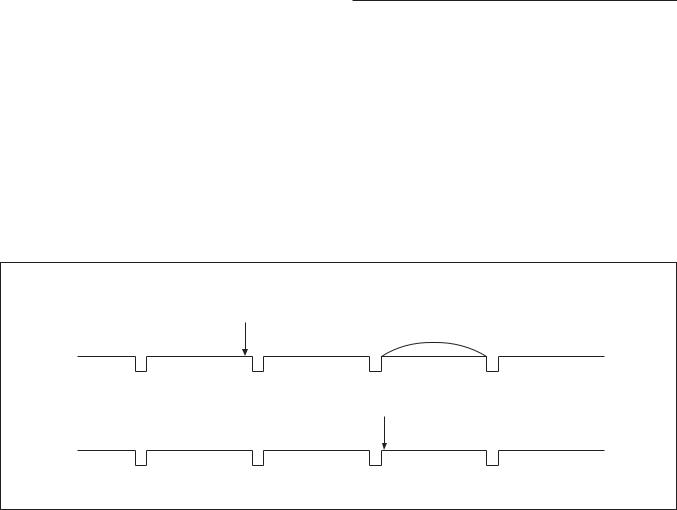
Basic Functions
Privacy Zone Masking Function Features
Privacy Zone masking protects private objects and areas such as house windows, entrances, and exits which are within the camera’s range of vision but not subject to surveillance.
Privacy zone masking can be masked on the monitor to protect privacy.
•Mask can be set on up to 24 places according to Pan/ Tilt positions.
•Mask can be displayed on 8 places per screen simultaneously.
•Privacy Zones are displayed according to priority in alphabetical order.
•Individual on/off zone masking settings.
•Two colors from among 29 colors including mosaic can be individually set for each of 24 privacy zones.
•Interlocking control with zooming.
•Interlocking control with Pan/Tilt.
•Non-interlocking control with Pan/Tilt.
Timing chart |
|
8x 01 |
.. .. FF |
(Mask Setting Command) |
|
|
1V |
|
Setting command is reflected |
|
at this timing. |
15
|
|
|
|
Basic Functions |
|
|
|
|
|
Privacy Zone Setting Command List |
|
|||
|
|
|
|
|
Command Set |
Command |
|
Command Packet |
Comments |
|
|
|
|
|
CAM_PrivacyZone |
SetMask |
|
8x 01 04 76 mm nn |
Setting Mask(Size) |
|
|
|
0r 0r 0s 0s FF |
See “mm: Mask setting list”, “nn: Setting”, and |
|
|
|
|
“pp: x, qq:y, rr: w, ss: h” in “Parameters” on |
|
|
|
|
page 17. |
|
|
|
|
|
|
Display |
|
8x 01 04 77 pp pp pp pp FF |
Setting Mask Display On/Off |
|
|
|
|
See “pp pp pp pp: Mask bit” in “Parameters” |
|
|
|
|
on page 17. |
|
|
|
|
pp pp pp pp: Mask setting (0: OFF, 1: ON) |
|
|
|
|
|
|
SetMaskColor |
|
8x 01 04 78 pp pp pp pp qq rr FF |
Setting Color of Mask |
|
|
|
|
See “pp pp pp pp: Mask bit” and “qq, rr: Color |
|
|
|
|
code” in “Parameters” on page 17. |
|
|
|
|
qq: Color setting when setting the Mask bit |
|
|
|
|
to 0 |
|
|
|
|
rr: Color setting when setting the Mask bit |
|
|
|
|
to 1 |
|
SetPanTiltAngle |
|
8x 01 04 79 0p 0p 0p 0q 0q 0q FF |
Setting Pan/Tilt Angle |
|
|
|
|
See “Setting pan/tilt angle” in “Parameters” on |
|
|
|
|
page 17. |
|
|
|
|
ppp: Pan angle, qqq: Tilt angle |
|
|
|
|
|
|
SetPTZMask |
|
8x 01 04 7B mm 0p 0p 0p |
Setting the direct position of PTZ |
|
|
|
0q 0q 0q 0r 0r 0r 0r FF |
See “mm: Mask setting list” and “Setting pan/ |
|
|
|
|
tilt angle” in “Parameters” on page 17. |
|
|
|
|
ppp: Pan , qqq: Tilt , rrrr: Zoom |
|
|
|
|
|
|
Non_InterlockMask |
|
8x 01 04 6F mm |
Setting non-interlocking the mask to pan/tilt |
|
|
|
0p 0p 0q 0q 0r 0r 0s 0s FF |
See “mm: Mask setting list” and “pp:x, qq:y, |
|
|
|
|
rr:w, ss:h” in “Parameters” on page 17. |
|
|
|
|
|
|
Grid On |
|
8x 01 04 7C 02 FF |
Setting Grid Display On/Off |
|
|
|
|
|
|
Grid Off |
|
8x 01 04 7C 03 FF |
|
|
|
|
|
|
|
CenterLineOn |
|
8x 01 04 7C 04 FF |
Setting the center line On |
|
|
|
|
|
|
|
|||
Privacy Zone Inquiry Command List |
|
|||
|
|
|
|
|
Inquiry Command |
Command Packet |
|
Inquiry Packet |
Comments |
|
|
|
|
|
CAM_Privacy |
8x 09 04 77 FF |
|
y0 50 pp pp pp pp FF |
Inquiry about the status of Setting Mask |
DisplayInq |
|
|
|
Display On/Off |
|
|
|
|
See “pp pp pp pp: Mask bit” in “Parameters” |
|
|
|
|
on page 17. |
|
|
|
|
1:On, 0:Off |
|
|
|
|
|
CAM_PrivacyPan |
8x 09 04 79 FF |
|
y0 50 0p 0p 0p 0q 0q 0q FF |
Inquiry about the pan/tilt position currently set |
TiltInq |
|
|
|
See “Setting pan/tilt angle” in “Parameters” on |
|
|
|
|
page 17. |
|
|
|
|
ppp: Pan, qqq: Tilt |
|
|
|
|
|
CAM_Privacy |
8x 09 04 7B mm FF |
|
y0 50 0p 0p 0p 0q 0q 0q 0r 0r |
Inquiry about pan/tilt/zoom position at the mm |
PTZInq |
|
|
0r 0r FF |
Mask setting |
|
|
|
|
See “mm: Mask setting list” and “Setting pan/ |
|
|
|
|
tilt angle” in “Parameters” on page 17. |
|
|
|
|
ppp: Pan Position, |
|
|
|
|
qqq: Tilt Position |
|
|
|
|
rrrr: Zoom Position |
|
|
|
|
|
CAM_Privacy |
8x 09 04 6F FF |
|
y0 50 pp pp pp pp FF |
Inquiry about the mask currently displayed |
MonitorInq |
|
|
|
See “pp pp pp pp: Mask bit” in “Parameters” |
|
|
|
|
on page 17. |
|
|
|
|
|
16

Basic Functions
Parameters
mm: Mask setting list
Mask Name |
mm (Hex) |
|
|
Mask_A |
00h |
|
|
Mask_B |
01h |
|
|
Mask_C |
02h |
|
|
Mask_D |
03h |
|
|
Mask_E |
04h |
|
|
Mask_F |
05h |
|
|
Mask_G |
06h |
|
|
Mask_H |
07h |
|
|
Mask_I |
08h |
|
|
Mask_J |
09h |
|
|
Mask_K |
0Ah |
|
|
Mask_L |
0Bh |
|
|
Note
Mask Name |
mm (Hex) |
Mask_M |
0Ch |
|
|
Mask_N |
0Dh |
|
|
Mask_O |
0Eh |
|
|
Mask_P |
0Fh |
|
|
Mask_Q |
10h |
|
|
Mask_R |
11h |
|
|
Mask_S |
12h |
|
|
Mask_T |
13h |
|
|
Mask_U |
14h |
|
|
Mask_V |
15h |
|
|
Mask_W |
16h |
|
|
Mask_X |
17h |
|
|
The priority order of the mask display is in the sequence from A (highest) to X (lowest).
When you set the parameters of masks non-sequentially, it is recommended that you set the mask whose priority order is higher, first.
nn:Setting
nn |
Setting |
|
|
00 |
Resetting the zone size (the value of w,h) |
|
for the existing mask. |
|
|
01 |
Setting newly the zone size (the value of |
|
w,h). |
|
|
pp: x, qq: y, rr: w, ss: h |
|
160 |
|
3Ch |
|
|
mask |
h |
w |
120 |
(x,y) |
0 |
|
B0h |
50h |
C4h
Effective display area
pp pp pp pp: Mask bit
|
pp |
|
|
|
|
|
|
|
pp |
|
|
|
|
|
|
|
pp |
|
|
|
|
|
|
|
pp |
|
|
|
|
|
|
|
||||
bit |
7 |
|
6 |
5 |
4 |
3 |
2 |
1 |
0 |
7 |
|
6 |
5 |
4 |
3 |
2 |
1 |
0 |
7 |
|
6 |
5 |
4 |
3 |
2 |
1 |
0 |
7 |
|
6 |
5 |
4 |
3 |
2 |
1 |
0 |
|
|
|
|
|
|
|
|
|
|
|
|
|
|
|
|
|
|
|
|
|
|
|
|
|
|
|
|
|
|
|
|
|
|
|
|
|
Mask |
- |
|
- |
X |
W |
V |
U |
T |
S |
- |
|
- |
R |
Q |
P |
O |
N |
M |
- |
|
- |
L |
K |
J |
I |
H |
G |
- |
|
- |
F |
E |
D |
C |
B |
A |
|
|
|
|
|
|
|
|
|
|
|
|
|
|
|
|
|
|
|
|
|
|
|
|
|
|
|
|
|
|
|
|
|
|
|
|
|
The “-” must be “0”.
qq, rr: Color code
Mask (Color) |
Code (qq, rr) |
Semi-transparency (qq, rr) |
|
|
|
Black |
00h |
10h |
Gray1 |
01h |
11h |
Gray2 |
02h |
12h |
Gray3 |
03h |
13h |
Gray4 |
04h |
14h |
Gray5 |
05h |
15h |
Gray6 |
06h |
16h |
White |
07h |
17h |
Red |
08h |
18h |
Green |
09h |
19h |
Blue |
0Ah |
1Ah |
Cyan |
0Bh |
1Bh |
Yellow |
0Ch |
1Ch |
Magenta |
0Dh |
1Dh |
Mosaic |
7Fh |
– |
|
|
|
Setting pan/tilt angle
Angle/Parameter of Angle (ppp, qqq)
-180 |
-90 |
0 |
90 |
180 |
800h |
C00h |
|
400h |
800h |
Set the angle resolution to 360 (degree)/4096 (1000h).
17
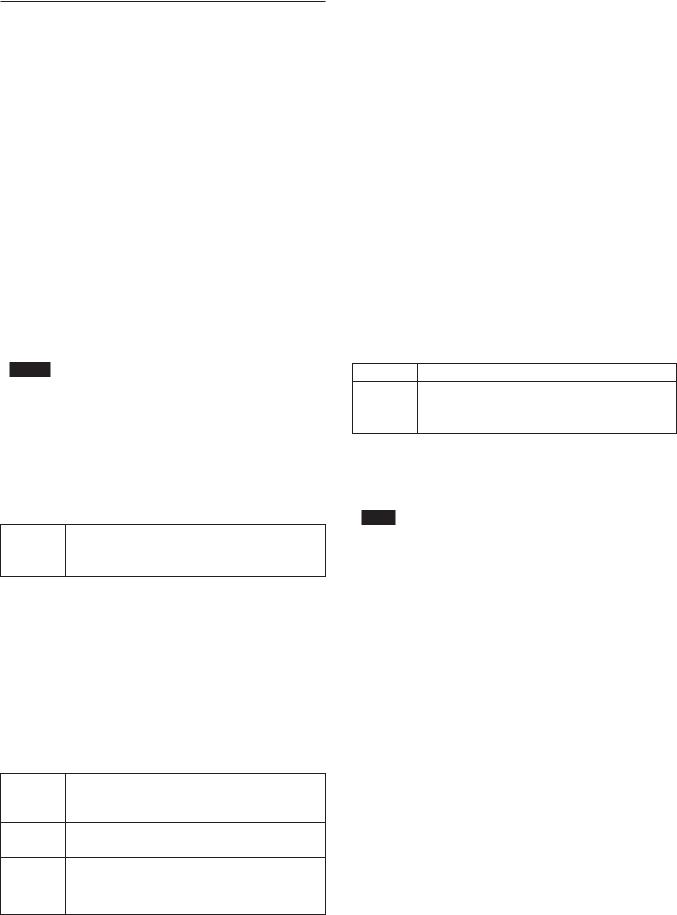
Details of Setting Commands
Set Mask
Command: 8x 01 04 76 mm nn 0r 0r 0s 0s FF
Parameters:
mm |
Setting Mask |
|
See “mm: Mask setting list” in “Parameters” on page 17. |
|
|
nn |
Selects new setting or resetting for the zone. See “nn: |
|
Setting” in “Parameters” on page 17. |
|
|
rr |
Sets the half value “w” of the Mask Width. |
|
|
ss |
Sets the half value “h” of the Mask Height. |
|
See “pp: x, qq: y, rr: w, ss: h” in “Parameters” on page 17. |
|
|
Comments: To set the mask, first display the object at the center of the screen. When “nn” is set to 1, the current Pan/Tilt/Zoom position is recorded in internal memory.
When “nn” is set to 0, the Pan/Tilt/Zoom position in memory is not changed.
Notes
•The tilt angle at which you can set the mask is between –70 to +70 degrees.
•It is recommended that you set the size to at least twice the size of the object (height and width).
Set Display
Command: 8x 01 04 77 pp pp pp pp FF
Parameter:
pp pp pp pp Each 24 Privacy Zones corresponds to 1 bit. See “pp pp pp pp: Mask bit” in “Parameters” on page 17.
Comments: Each of 24 Privacy zones can be switched on and off individually by a single VISCA command. If you want to display a Privacy zone, you must set its bit to 1. If you do not want to display a Privacy zone, you must set its bit to 0.
Set Mask Color
Command: 8x 01 04 78 pp pp pp pp qq rr FF
Parameter:
pp pp pp pp Each 24 Privacy Zones correspond with the BIT. See “pp pp pp pp: Mask bit” in “Parameters” on page 17.
qqSet the color code include the semi-transparency code.
rrSet the color code include the semi-transparency code. See “qq, rr: Color code” in “Parameters” on page 17.
Basic Functions
Comments: Two different color masks can be chosen.
The colors can be chosen from among 14 colors including the possibility for semi-transparency of each color. Therefore two colors from among the total of 29 colors including mosaic can be individually set for each of 24 privacy zones.
If the bit of parameter (pp pp pp pp) is set to “0”, mask color will be “qq” color (Color code). If the bit of parameter (pp pp pp pp) is set to “1”, the mask color will be “rr” color (Color code).
Example: 8x 01 04 78 00 00 00 03 10 07 FF
The mask color of Mask_A and Mask_B is White (color code 07h), and the mask color of the other Mask (C to X) is semi-transparent Black (color code 10h).
Set Pan Tilt Angle
Command: 8x 01 04 79 0p 0p 0p 0q 0q 0q FF
Parameter:
pppPan Angle
qqqTilt Angle
See “Setting pan/tilt angle” in “Parameters” on page 17.
Comments: Pan/Tilt angle settings are hexadecimal data.
The resolution of Pan/Tilt angle is 0.088 degrees.
Note
When you set the pan/tilt angle, locate the pan/tilt position at the center point of the FCB camera’s position.
Set PTZ Mask
Command: 8x 01 04 7B mm 0p 0p 0p 0q 0q 0q 0r 0r
0r 0r FF
Parameter:
mm |
Setting Mask |
|
See “mm: Mask setting list” in “Parameters” on page 17. |
|
|
ppp |
Pan Angle (000 to FFF) See “Setting pan/tilt angle” on |
|
page 17. |
|
|
qqq |
Tilt Angle (000 to FFF) See “Setting pan/tilt angle” on |
|
page 17. |
|
|
rrrr |
Zoom Position (000 to 4000) See “Zoom Ratio and Zoom |
|
Position (for reference)” on page 55. |
|
|
Comments: Mask can be set at the desired position by setting the pan tilt angle and zoom position using this command. The set value can be input by hexadecimal number.
18
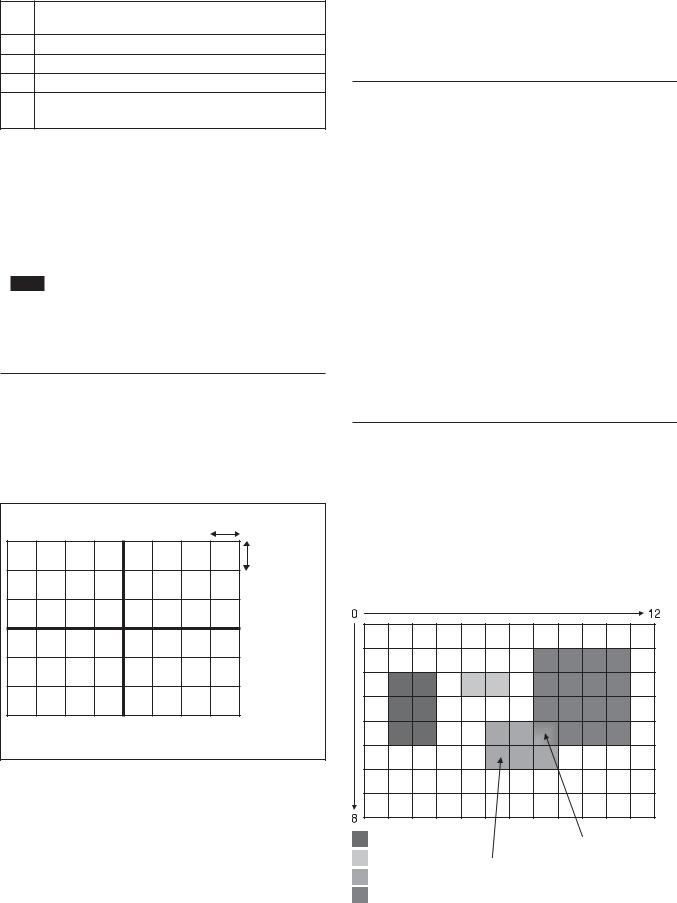
Non Interlock Mask
Command: 8x 01 04 6F mm 0p 0p 0q 0q 0r 0r 0s 0s
FF
Parameters:
mm Setting Mask
See “mm: Mask setting list” in “Parameters” on page 17.
pp Sets the center position “x” of the Mask on screen.
qq Sets the center position “y” of the Mask on screen.
rr Sets the half value “w” of the Mask Width.
ss Sets the half value “h” of the Mask Height.
See “pp: x, qq: y, rr: w, ss: h” in “Parameters” on page 17.
Commands: Mask does not interlock with pan/tilt. The limitations of parameters are as follows. (hexadecimal representation)
x:±50h
w:±50h
y:±3ch
h:±3ch
Note
When the Set Mask command and the Non Interlock Mask command are set to the same mask, the command set later becomes effective.
Grid
Use the grid displayed on the screen to set mask positions (see the figure below).
By executing the Center Line On command, only the x and y axes of the center are displayed. Grids lines disappear.
14hex (20(10))
14hex (20(10))
Basic Functions
Motion Detection Function
This function instructs the camera to detect movement within the monitoring area and then send an alarm signal automatically.
The Detect signal goes out through the serial command (VISCA) communication line.
Features
•You can set a frame for the detection range of 12 (horizontally) × 8 (vertically) blocks.
•You can set up to four frames.
•When the motion is detected in the set frame, the Alarm Replay VISCA command is sent.
•The threshold level for detection can be set (common to four frames).
•The interval of alarm detection can be set up to 256 seconds in units of one second.
•You can set on/off for each frame.
•When the Block Mode is set to ON, the Alarm Reply command is not sent. Use this mode for checking when the camera is installed or for confirming the camera operation.
•The frame number is also sent with Alarm Replay to report in which frame the motion has been detected.
Frames
Setting frames
You can set the frame by assigning the starting point and terminating point vertically and horizontally. You can set up to four frames.
When motion is detected within the rage where frames overlap
The alarms are sent for both frames.
Frame 1
Frame 2
Frame 3
Frame 4
At this position, the alarm for frame 3 is sent.
Within this overlapped range, alarms are sent for both frame 3 and frame 4.
19
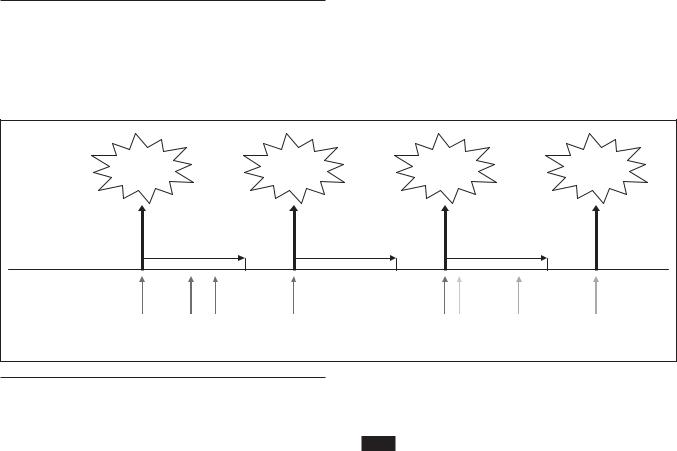
Sending Alarms
•When motion is detected, the Alarm Replay command is issued via the serial command (VISCA) communication line.
Basic Functions
•When multiple motions are detected or motion is detected in another frame within the set interval following the original time the alarm was issued, another alarm command is not issued.
•When motion is detected after the interval time elapsed, the alarm is issued again.
Alarm issue |
Alarm issue |
Alarm issue |
Alarm issue |
Interval |
Interval |
Interval |
Alarm interval
Motion is |
Motion is |
Motion is |
Motion is |
detected |
detected |
detected |
detected |
in frame 1. |
in frame 1. |
in frame 1. |
in frame 1. |
Motion is |
Motion is |
Motion is |
Motion is |
detected |
detected |
detected |
detected |
in frame 1. |
in frame 2. |
in frame 3. |
in frame 3. |
Setting Commands
•MD On/Off
The Display mode is selected by the Function Set command and frames are set by the Frame Set command. By sending an MD On command, the frame is displayed when motion is detected in the set frame. The Alarm Reply command is set via the serial command (VISCA) communication line.
8x 01 04 1B 02 FF --- |
On |
8x 01 04 1B 03 FF --- |
Off |
•Function Set
Select the detected frame, and set the Threshold Level and the Interval Time.
8x 01 04 1C 0m 0n 0p 0q 0r 0s FF
m: Display Mode on/off (bit0: Frame)
n:Detection Frame set on/off (bit0:Frame0, bit1:Frame1, bit2:Frame2, bit3:Frame3)
--(0 to F)
pq: Threshold |
-- (00 to FF) |
rs: Interval time set |
-- (00 to FF) |
(When pq and rs are 0, the command is received, but the setting is disabled.)
•Frame Set
You can set up to four frames by assigning the starting and terminating points.
Note
Set a terminating point higher vertically and horizontally than the starting point. If you set the wrong value, the command yields an error.
8x 01 04 1D 0m 0p 0q 0r 0s FF
m: Select Detection Frame (0: Frame0, 1: Frame1, 2:
|
Frame2, 3: Frame3) |
-- (0, 1, 2, 3) |
p: |
Frame set Start Horizontal Position |
-- (00 to 0B) |
q: |
Frame set Start Vertical Position |
-- (00 to 07) |
r: |
Frame set End Horizontal Position |
-- (01 to 0C) |
s: |
Frame set End Vertical Position |
-- (01 to 08) |
•Alarm Reply
When motion is detected in the set frame, the camera issues this command. This command includes the information on the number of the detected frame.
y0 07 04 1B 0p FF
p:Frame Number (bit0: Frame0, bit1: Frame1, bit2: Frame2, bit3: Frame3)
20
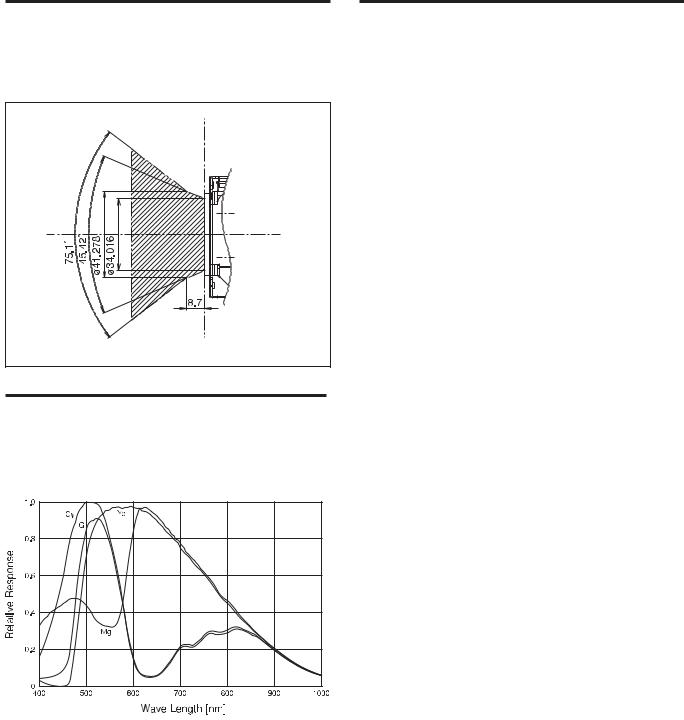
Eclipse
When designing the housing, refer to the dimensional allowance as shown in the figure below.
Spectral Sensitivity
Characteristics
Use the graph as a reference value. (We can not guarantee these values.)
This data is measured when the IR cut filter is removed and the characteristics of the lens and optical source characteristics are ignored.
Basic Functions
Vibration
Specifications
Test Method (Random vibration)
•Fix the camera at the four fixation points of the base using M2 screws.
•Perform the random vibration test under the following conditions in the X, Y and Z directions for 20 minutes in each direction.
•The camera vibration specification is to have no malfunction after this test.
Power spectrum density |
5 to 50 Hz |
4.14 m2/s3 |
{0.043 G2/Hz} |
|
50 to 100 Hz |
–36 dB/oct |
|
|
|
|
|
Effective overall value |
14.3 m/s2 |
{1.46 G} |
|
|
|
|
|
Test time |
20 minutes |
|
|
|
|
|
|
21
